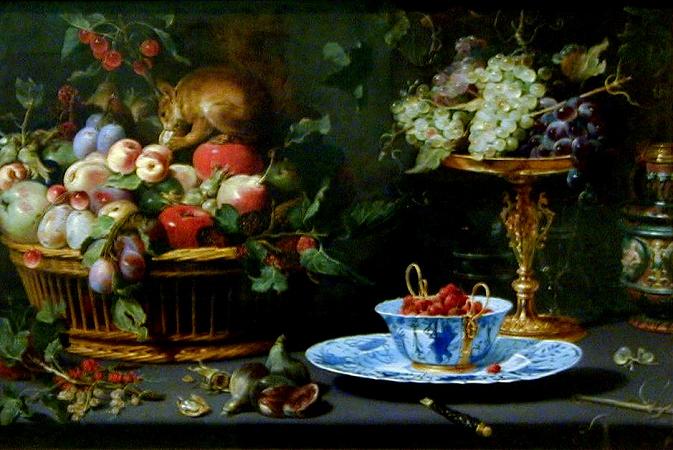Prometheus Bound (1618). Oil on canvas. 243 x 210. Prometheus Bound is an oil painting by Peter Paul Rubens, a Flemish Baroque artist from Antwerp. Influenced by the Greek play, Prometheus Bound, Peter Paul Rubens completed this painting in his studio with collaboration from Frans Snyders, who rendered the eagle. It remained in his possession from 1612 to 1618, when it was traded in a group of paintings completed by Rubens, to Englishmen Sir Dudley Carleton in exchange for his collection of classical statues. This work is currently in the collection of the Philadelphia Museum of Art, Pennsylvania. In 1582, Peter Paul Rubens first apprenticed with a distance relative, Tobias Verhaecht, a landscape painter. Rubens spent a short time in his studio, learning the basics of composing a landscape. These lessons would influence his work, including Prometheus Bound, as the backgrounds of many of his paintings play an important role in the composition. Rubens then apprenticed for four years with Adam van Noort, a portrait painter, known for painting mythological scenes with plentiful nudes, and unrestrained images of Flemish life. Before starting his own studio, Rubens worked with Otto van Veen, from 1594 to 1598. Here, Rubens learned composition and the iconography of history painting, demonstrated in Prometheus Bound with the foreshortened figure positioned close to the viewer and the use of iconography derived from an ancient Greek play. In 1610, Rubens open a studio of his own in Antwerp, while also serving as court painter to the Archduke and Archduchess in Brussels. In the same period of Prometheus Bound, Rubens was also painting The Descent from the Cross, a commissioned altarpiece. After setting up his own studio, Peter Paul Rubens had many important commissions. He collaborated with artists that were regarded as masters in their field of study. For Prometheus Bound, Rubens collaborated with Frans Snyders, a master of animal and hunting scenes, for the eagle. Prometheus Bound, a Greek play attributed to Aeschylus, but thought to have been completed by another after Aeschylus' death in 456 B.C. It is possible that Prometheus Bound is the second play written by Aeschylus in a connected trilogy, followed by Prometheus lyomenos, of which only a few fragments have survived. In the play, Prometheus, the Titan, had assisted Zeus in establishing rule over Cronus and the other Titans, but infuriated Zeus by becoming the champion of mortals and giving them fire and the arts. In the opening of the play, Zeus ordered Hephaestus, Kratos and Bia to nail Prometheus to a high rock in Caucasus, to suffer torment as long as Zeus wishes. Prometheus's punishment is for stealing fire from Mount Olympus to give to humanity. Zeus, the King of Olympians, ordered Prometheus to be chained to a rock and suffer torment, by having an eagle devour Prometheus's perpetually regenerating liver everyday. Peter Paul Rubens would have used these Greek influences to carry out his own interpretation of the story. When he painted a classic or mythological subject, he was glorifying human creation, expressing his own joy at the beauty of the world. In Prometheus Bound, he depicts a suffering victim, Prometheus, but also the beauty of the Eagle causing the torment. In Rubens's interpretation, the enormous eagle's beak rips open Prometheus's torso, exposing bloody entrails. The eagle's talons gouge into Prometheus's right eye, while his left eye is focused on the predator, indicating that he is aware of his torture. Agony is conveyed in his clenched fists, writhing legs, and tousled hair. The liver was chosen as the source for torture, as Greeks regarded the liver as intelligence, soul, and the seat of life. The art of Rubens is related to the attitudes expressed by his brother Philip and his teacher Justus Lipsius regarding the Counter Reformation. They studied Greek and Roman writing and ideas, but saw pagan mythology as an indirect tribute to the power of the Christians' one God. A poem written by Lipsius, a professor and friend of Rubens's brother Philip, describes the intended response of the viewer: Here, with hooked beak, a monstrous vulture digs about in the liver of Prometheus, who is given no peace from his torments as ever and again the savage bird draws near his self-renewing breast and attacks it punishingly. He is not content with his inhuman sacrificial feast, but with his claws lacerates, here the agonized face, there the man's thigh. He would fly murderously on the spectators, did not his chained prey detain him. He can do no more that terrify the frightened onlookers by turning his flaming eyes from one to the other. Blood flows from the chest and every part where his claws leave their mark, and his piercing eyes dart savage flames.
more...






